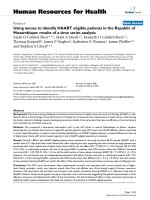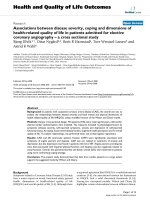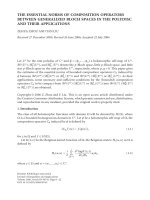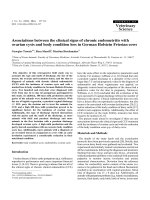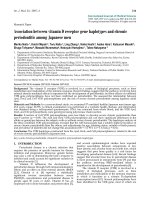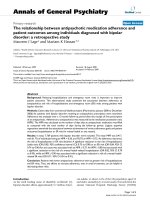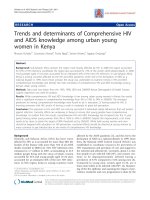Associations between rapid weight gain in infancy and weight status among urban Aboriginal children participating in the Gudaga study: Nine-year results from a cohort study
Bạn đang xem bản rút gọn của tài liệu. Xem và tải ngay bản đầy đủ của tài liệu tại đây (1.11 MB, 7 trang )
Denney-Wilson et al. BMC Pediatrics
(2020) 20:224
/>
RESEARCH ARTICLE
Open Access
Associations between rapid weight gain in
infancy and weight status among urban
Aboriginal children participating in the
Gudaga study: nine-year results from a
cohort study
Elizabeth Denney-Wilson1,2* , Kaniz Fatema3, Emma Elcombe4, Suzanne Ingram3, Mark Harris5 and
Elizabeth Comino3
Abstract
Background: Rapid weight gain (RWG) in infants is associated with overweight and obesity in childhood and
beyond, highlighting the need for early intervention.
Methods: Data from a birth cohort of Australian Aboriginal and Torres Strait Islander children living in an urban
area were analysed to determine the prevalence of RWG in infancy and the association between RWG and
overweight and obesity, categorised using both body mass index and waist to height ratio from birth to 9 years.
Results: The prevalence of overweight and obesity is higher in this cohort (at 47%) than the population average.
The Australian population as a whole has seen steady increases. In this cohort although the prevalence of
combined overweight and obesity remained relatively stable between 2 and 9 years, the proportion of children
categorized as obese using BMI has increased. 42% of children who were overweight or obese at 9 years had
experienced RWG in infancy. Children were 2.7 and 3.9 times more likely to be overweight at 9 years if they
experienced RWG or were overweight at 2 years, respectively.
Conclusion: RWG was common in this cohort and the strongest predictor of excess weight at 2 years and at 9
years. Early intervention is crucial in the first year of life across the whole population to prevent obesity in children.
Culturally appropriate interventions developed with the community are required for Aboriginal and Torres Strait
Islander babies and their parents.
Keywords: Child obesity, Rapid weight gain, Aboriginal children, Body mass index, Waist to height ratio
* Correspondence:
1
Faculty of Medicine and Health, The University of Sydney, Camperdown,
New South Wales 2050, Australia
2
Sydney Local Health District, Sydney, New South Wales, Australia
Full list of author information is available at the end of the article
© The Author(s). 2020 Open Access This article is licensed under a Creative Commons Attribution 4.0 International License,
which permits use, sharing, adaptation, distribution and reproduction in any medium or format, as long as you give
appropriate credit to the original author(s) and the source, provide a link to the Creative Commons licence, and indicate if
changes were made. The images or other third party material in this article are included in the article's Creative Commons
licence, unless indicated otherwise in a credit line to the material. If material is not included in the article's Creative Commons
licence and your intended use is not permitted by statutory regulation or exceeds the permitted use, you will need to obtain
permission directly from the copyright holder. To view a copy of this licence, visit />The Creative Commons Public Domain Dedication waiver ( applies to the
data made available in this article, unless otherwise stated in a credit line to the data.
Denney-Wilson et al. BMC Pediatrics
(2020) 20:224
Background
Recent data suggests that the population prevalence of
combined overweight and obesity among Australian primary school aged children is relatively stable at 25%;
however, substantial socioeconomic and cultural disparities exist and require attention [1]. In particular, children from low socioeconomic status backgrounds are
twice as likely to be overweight or obese compared with
their more advantaged peers [1, 2]. Of particular concern
is that the prevalence of combined overweight and obesity among children from Aboriginal and Torres Strait Islander backgrounds is much higher than the population
average, with data from the Australian Bureau of Statistics suggesting 40% of 10 year old children are either
overweight or obese [3]. Aboriginal and Torres Strait Islander peoples hold distinct cultural identities whether
they live in urban, regional or remote areas of Australia.
The appropriate terminology referring to Aboriginal and
Torres Strait Islander peoples is locally determined. Both
Aboriginal and Torres Strait Islander people are included in the term ‘Aboriginal’ throughout this paper.
Improving the health outcomes for Aboriginal
Australians has been a major priority of successive national and state governments during recent years. The
Closing the Gap [4] strategy was introduced in 2008 to
underline the importance of reducing health disparities
and to coordinate activities and their funding. Targeting
overweight and obesity will address one major risk factor
for the health of Aboriginal Australians in childhood
and in adult life. As a first step, it is important to explore
the patterns of weight gain across childhood and to
understand potential associations with weight gain in
later life. This information is crucial to guide the development of culturally relevant and timely interventions
for Aboriginal children, many of whom live in urban
areas of Australia and may have different risk factors
and environmental exposures from Aboriginal Australians living in rural and remote areas.
The Gudaga study included measurement of participant’s growth from 0 to 9 years. In this paper, we report
on weight status, patterns of growth and explore the associations between rapid weight gain (RWG) and obesity
at 9 years as categorised by both body mass index (BMI)
and waist-to-height-ratio (WHtR).
Methods
Gudaga study summary
The population and methods of the Gudaga Study have
been previously published [5]. Briefly, mothers of Aboriginal children were identified within the maternity ward
of Campbelltown Hospital in outer urban Sydney, New
South Wales, Australia, between May 2005 and October
2007 and recruited to the cohort. Participating parents
agreed to data collection and to the extraction of their
Page 2 of 7
child’s data from available health service records. Interviews with mothers were undertaken at 2–3 weeks of
age, and then at 6-monthly intervals from 6 months to 9
years of age. Anthropometric measures were collected at
interview during the preschool years and then annually
once children were at school. In total, 159 mothers and
their children were identified at birth, and 149 were recruited at the first formal interview at 2–3 weeks of age.
Anthropometry
Anthropometric measures included height, weight, head
circumference and waist circumference (from 36 months
of age). Height was measured to the nearest 0.1 cm in
bare feet. Body weight was measured to the nearest 0.1
kg with a balance-beam scale with participants wearing
lightweight clothing. BMI (kg/m2) was calculated as
weight (kg) divided by the square of height (m). Waist
circumference was measured to the nearest 0.1 cm at the
mid-point between the lower costal border and the top
of the iliac crest with the measurement taken at the end
of a normal expiration. WHtR was calculated as waist divided by height.
Final sample
Children who withdrew from the study prior to their 18
month interview (n = 27) were excluded from this analysis, as were children without anthropometric measures
at birth or 12 months of age (n = 4). One hundred and
twenty-eight children were included in this study.
Statistical analysis
All analyses were conducted using IBM SPSS V22.0 for
Windows (Armonk, NY: IBM Corp). Continuous and
categorical data were summarised using conventional
summary statistics based on the mean measure with
standard deviation (SD) for continuous variables, or proportion with the attribute of interest for categorical variables and their associated standard error. Logistic
regression was used to calculate the relationship between
selected risk factors and overweight or obesity at 9 years
of age in both univariate and multivariate models. Variables with a statistical significance less than 0.2 in the
univariate analysis were included in the multivariate
model. The multivariate model used the backward stepwise method to consider the effect of selected risk
factors.
Child weight, height (or length for children under 2
years of age), waist and BMI values were standardised
using the Centre for Disease control (CDC) 2000 LMS
method of standardisation [6]. The standardised measures were expressed as a z-score and percentile rank
score.
The variables tested in the regression models included
maternal factors (smoking, marital status, age, education,
Denney-Wilson et al. BMC Pediatrics
(2020) 20:224
and a measure of socioeconomic status by suburb of
residence, the Socio-Economic Indexes for Areas
(SEIFA)); infant measures at birth (female child, low
birth weight (< 2.5 kg), prematurity (less than 37 weeks
gestation), and small for gestational age (SGA)), and infant measures during the first 12 months of life (breastfeeding and RWG). RWG was defined as an increase in
weight-for-age SD score greater than or equal to 0.67
between birth and 12 months of age [6].
Ethics
Signed informed consent was obtained from the mothers
of all participating children at birth, 12 months and 5
years. The study has the cooperation and support of the
local Aboriginal community [5, 7].
This study was approved by the ethics committees of
the Aboriginal Health and Medical Research Council
(679/11) and the South West Sydney Local Health District (HREC/10/LPOOL/202).
Results
Cohort description
Data for this paper was available for 128 Aboriginal children. The full cohort includes 149 child/parent dyads
and the characteristics of the dyads included in this
paper did not differ significantly from the full cohort
(data not shown). At time of birth, mothers of Aboriginal infants were on average, aged 25.6 years (SD = 6.53);
23% were aged less than 20 years of age; 42% were single;
55% lived in a suburb classified within the lowest SEIFA
quintile; 25% had not completed year 10 of high school;
and more than 50% of mothers smoked during their
pregnancy. Low rates of breastfeeding were reported,
with 65% of Aboriginal infants receiving any breast milk
and only 13% being partly or completely breastfed at 20
weeks. At birth, 7% of infants weighed less than 2.5 kg,
8% were born premature (less than 37 weeks gestation),
mean gestation length was 39.4 weeks (SD = 1.8) and
12.5% were considered SGA.
Patterns of growth
The patterns of growth (height, weight and waist) are
summarised in Fig. 1 (a, b, c, d and e). At birth, infants
averaged 50.2 cm (SD = 3.02) in length and 3.4 kg (SD =
0.56) in weight. When infant weight was standardised,
the mean standardised weight-for-age z-score at birth
was − 0.22. At 3 years of age, average child height was
96.2 cm (SD = 4.37) and weight was 15.6 kg (SD = 2.43);
and the mean weight-for-age z-score had risen over half
a SD to be 0.52 above the CDC standard. At 9 years of
age, average child height was 136.0 cm (SD = 7.2), and
weight was 37.8 kg (SD = 11.5); and the mean standardised weight-for-age z-score was 0.69 SD above the
CDC Standard.
Page 3 of 7
Growth measurement standardisation and percentile
banding
The age standardised percentiles for children’s growth
are shown in Fig. 2. The majority of Aboriginal children
at each age were within normal height (Fig. 2 a) and
weight (Fig. 2 b) ranges (10th–85th percentile), as 66–
74% and 46–74% respectively.
Using the BMI z-score categorisation, 34% of the cohort were categorised as being overweight or obese
(85th percentile and above) at 3 years. Just over 50% of
children at 5, 7 and 9 years of age had a healthy BMI
(10th–85th percentile) compared to the target percentage of 75% (Fig. 2 b). The proportion of overweight and
obese children rose to 45% by 5 years of age, then to
48% by 9 years of age.
Waist-to-height ratio or waist-to-stature ratio
Using WHtR categorisation, there are no extremely slim
children in the ≤5th percentile and only 1.7% of children
were slim (5th–10th percentile) at the age of 3 years. Almost 41% were within the optimum healthy range
(10th–85th percentile) and 57.4% of the cohort were recorded as being ‘overweight’ or ‘very obese’ (85th percentile and above) at 3 years of age. The proportion of
‘very slim and slim’ (10th percentile and below) and
‘overweight and obese’ children rose to 10.2 and 33.7%
respectively by 5 years of age, then to 23.6 and 40.4% by
7 years, and 25.9 and 43.2% by 9 years of age. At the ages
of 7 and 9 years, only 36 and 31% of the cohort fell into
the healthy band of WHtR (Fig. 2 d).
Associations between rapid weight gain and overweight
and obesity
At 9 years of age, 37 children (47%) of the cohort had a
BMI-for-age above the 85th percentile. At 2 years of age,
RWG in the first 12 months was significantly associated
with overweight and obesity. RWG remained significantly associated with overweight and obesity at 9 years
of age (p < 0.006). In addition to RWG, having a BMI
over the 85th percentile at 2 years of age was associated
with overweight and obesity at 9 years of age (p < 0.002)
The variables tested in the regression models are shown
in Table 1.
In the combined model, children who experienced
RWG were 2.7 times more likely to be overweight at 9
years than children who did not experience RWG. Similarly, children who had a BMI over the 85th percentile
at 2 years were 3.9 times more likely to be overweight at
9 years of age, compared to children who were not overweight at 2 years of age. Female children were 2.4 times
more likely to be overweight at 9 years of age, than
males. None of the other factors tested in the model
achieved significance.
Denney-Wilson et al. BMC Pediatrics
(2020) 20:224
Page 4 of 7
Fig. 1 Patterns of growth for Gudaga children from birth to 9 years of age a: Mean height (cm) together with 95% confidence intervals b: Mean
weight (kg) together with 95% confidence intervals c: Mean waist (cm) together with 95% confidence intervals d: Mean body mass index
together with 95% confidence intervals and the median BMI, or the 50th percentile, at each age according to the CDC 2000 data set. e: Mean
waist-to-height ratio together with 95% confidence intervals
Denney-Wilson et al. BMC Pediatrics
(2020) 20:224
Page 5 of 7
Fig. 2 Children within each age standardised percentile band from birth to 9 years of age. a: Height for age b: Weight for age c: BMI for age d:
Waist-to-height ratio for ageBody mass index
Discussion
This study aimed to describe the growth trajectories of
Australian Aboriginal children from 0 to 9 years within
an urban setting and to determine whether children who
experienced RWG and were overweight or obese at 2
years remain above a healthy weight at 9 years of age.
Just over half the Gudaga children were in the healthy
weight range at each time point up to 9 years. The
prevalence of combined overweight and obesity is higher
than the population average, and has remained relatively
stable over time. However the proportion of children in
the obese range has increased. Similarly, data from the
New South Wales Schools Physical Activity and Nutrition Survey suggested that among children from low socioeconomic backgrounds, the prevalence of combined
overweight and obesity had increased from 29.1% in
2010 to 33.7% in 2015 [1].
At 9 years of age, factors from early life: RWG and
having a BMI above the 85th centile at 2 years of age,
were the most significant predictors of overweight and
obesity among the Gudaga cohort. RWG has been consistently associated with child and adult obesity with a
recent meta-analysis of 17 studies finding that infants
who experienced RWG were at 3.66 times (2.59–5.17,
95% CI) greater odds of being overweight or obese later
in life (from ages 2 to 46.5 years), than those who did
not experience RWG [8].
Infants fed with formula are more likely to experience
RWG [9] with data from an Australian cohort finding
that the only two modifiable risk factors associated with
RWG were formula feeding and feeding to a schedule.
In the Gudaga cohort both initiation and duration of
breastfeeding were very low, with only 53% of mother’s
initiating breastfeeding and only 10% still breastfeeding
at 20 weeks. Therefore, formula feeding was more common in this cohort than in the general population and
may explain some of the RWG. Both the content of formula (some studies suggest that formula with a higher
protein content is associated with RWG) [10] and feeding practices may be implicated.
A recent review has found that some infant formula
feeding practices are associated with RWG [11] such as
higher volumes of formula, pressure to finish a bottle
and using a bottle to put an infant to bed. This suggests
that interventions aimed at increasing the duration of
breastfeeding and promoting formula feeding practices
such as providing formula with lower protein content,
not putting a baby to bed with a bottle and not overfeeding formula may be important prevention strategies for
all children [9].
This study adds to the evidence that early intervention,
in the first year of life is crucial in tackling child and
adult obesity. Preventing RWG in infancy through strategies such as promoting breastfeeding and providing
support for parents who are formula feeding to ensure
that overfeeding does not occur are urgently needed for
all families (Fig. 3).
Strengths and limitations
While our sample size is relatively small, this is, to
our knowledge, the first study to provide detailed longitudinal growth data from a cohort of Australian
Denney-Wilson et al. BMC Pediatrics
(2020) 20:224
Page 6 of 7
Table 1 Risk factors for overweight and obesity at 9 years of age among Aboriginal children participating in the Gudaga Study
Demographics
Birth
n (%)
Univariate
(n = 79)
9 years
n (%)
Exp (β)
Multivariate
Exp (β)
p-value
✓
–
ns
✓
2.564
0.082
p-value
Mother single
74 (58%)
45 (57%)
0.71
0.455
Mother aged < 20 years
29 (23%)
10 (13%)
0.69
0.585
Low maternal education
32 (25%)
17 (22%)
0.95
0.923
Lowest SEIFA
70 (55%)
47 (60%)
0.58
0.233
Female infant
68 (53%)
44 (56%)
1.80
0.200
Low infant birth weight (< 2500 g)
9 (7%)
5 (6%)
0.25
0.225
Premature infant (< 37 weeks)
10 (8%)
6 (8%)
0.51
0.458
SGA infant
16 (13%)
10 (13%)
1.73
0.424
Maternal smoking during pregnancy
77 (61%)
48 (61%)
2.34
0.074
Breastfeeding at discharge
68 (53%)
42 (53%)
0.78
0.588
Breastfeeding for > 20 weeks
17 (13%)
8 (10%)
1.62
0.530
RWG (0–12 months)
43 (34%)
33 (42%)
3.75
0.006
✓
3.241
0.034
45 (37%)
30 (40%)
4.82
0.002
✓
3.157
0.037
a
BMI >85th at 24 months
BMI Body mass index
Exp(B): estimate for fixed effect: represents of odds of the child being overweight or obese when the risk factor is present, compared to when the risk is
not present
RWG Rapid weight gain
SEIFA Socio-economic indexes for areas
Low Education - did not complete year 10
SGA Small for gestational age
a
Measure missing for 3 participants
✓ = item included in multivariate model
Aboriginal children living in an urban area in Sydney.
We did not explore the impact of genetic or environmental factors on the high rates of overweight and
obesity and RWG, and we do not have reliable information on the antenatal weight gain or care of the
mothers. We did not examine the perception of infant
growth among Gudaga parents or the local Aboriginal
community.
The consistency of the study team including a local
Aboriginal woman conducting data collection is a key
strength of the study.
Conclusion
This study found high rates of overweight and obesity at
9 years of age in a cohort of Aboriginal children in Sydney, Australia. RWG in the first year of life and being
overweight at 2 years were associated with obesity at
9 years. RWG is a modifiable risk factor for obesity and
should be targeted by health services through interventions that are tailored to infant feeding method and are
culturally appropriate.
Abbreviations
BMI: Body mass index; CDC: Centers for disease control and prevention;
RWG: Rapid weight gain; SD: Standard deviation; SEIFA: Socio-economic
indexes for areas; SGA: Small for gestational age; WHtR: Waist-to-height ratio
Acknowledgements
The authors thank the Tharawal Aboriginal community in south-western Sydney and the families who participated in this study as well as the investigators and the research team who contributed to the study.
Fig. 3 BMI z-score by RWG
Authors’ contributions
EDW conceived the analyses and wrote the first draft of the paper. KF and
EE conducted the data management and analyses and provided comments
Denney-Wilson et al. BMC Pediatrics
(2020) 20:224
on the paper and interpretation of findings. SI commented on the paper
and managed the study. MH provided input into study findings and edits to
the paper. EC conceived the Gudadga study and provided input to analyses,
interpretation and the paper. All authors have approved the final version of
the manuscript prior to submission.
Author’s information
EDW is a Conjoint Professor of Nursing at The University of Sydney and
Sydney Local Health District. KF is a Research Development Officer with the
Centre for Health Equity Training, Research and Evaluation (CHETRE) at the
University of New South Wales and South Western Sydney Local Health
District. EE is a Senior Research Officer with Western Sydney University. SI is
the Aboriginal and Torres Strait Islander Health Lead with CHETRE at the
University of New South Wales and South Western Sydney Local Health
District. MH is the Scientia Professor and Executive Director at the Centre for
Primary Health Care and Equity at the University of New South Wales. EC is
an Associate Professor with CHETRE at the University of New South Wales
and South Western Sydney Local Health District.
Funding
The Gudaga study is funded by the National Health and Medical Research
Council (300430, 510171). The funding body had no role in the design,
conduct or reporting of the study.
Availability of data and materials
The datasets generated and/or analysed during the current study are not
publicly available due to data sharing stipulations in the ethics application
but are can be requested from the corresponding author and the
community custodians.
Ethics approval and consent to participate
This study was approved by the Ethics Committees of the Aboriginal Health
and Medical Research Council (679/11), and the South West Sydney Local
Health District (HREC/10/LPOOL/202). The study has the cooperation and
support of the local Aboriginal community. Parents provided written
informed consent.
Consent for publication
Not applicable.
Competing interests
The authors declare that they have no competing interests.
Author details
Faculty of Medicine and Health, The University of Sydney, Camperdown,
New South Wales 2050, Australia. 2Sydney Local Health District, Sydney, New
South Wales, Australia. 3Centre for Health Equity Training, Research and
Evaluation (CHETRE), part of the Centre for Primary Health Care and Equity,
Faculty of Medicine, University of New South Wales, Sydney, New South
Wales 2052, Australia. 4Translational Research and Social Innovation, School
of Nursing and Midwifery, Western Sydney University, Penrith, New South
Wales 2751, Australia. 5Centre for Primary Health Care and Equity, Faculty of
Medicine, University of New South Wales, Sydney, New South Wales 2052,
Australia.
1
Received: 26 March 2019 Accepted: 5 May 2020
References
1. Hardy L, et al. NSW schools physical activity and nutrition survey (SPANS).
Sydney: NSW Department of Health; 2017.
2. O'Dea JA, Chiang H, Peralta LR. Socioeconomic patterns of overweight,
obesity but not thinness persist from childhood to adolescence in a 6-year
longitudinal cohort of Australian schoolchildren from 2007 to 2012. BMC
Public Health. 2014;14:222.
3. Australian Bureau of Statistics. Census of Population and Housing: Details of
Overcount and Undercount. 2016.
4. Altman JC. Beyond closing the gap: Valuing diversity in Indigenous
Australia, Centre for Aboriginal Economic Policy Research. Canberra; 2009.
5. Comino E, et al. The Gudaga study: establishing an aboriginal birth cohort
in an urban community. Aust N Z J Public Health. 2010;34:S9–S17.
Page 7 of 7
6.
Kuczmarski RJ. 2000 CDC growth charts for the United States; methods and
development. USA: National Center for Health Statistics; 2002.
7. Comino EJ, et al. The Gudaga research program: a case study in
undertaking research with an urban aboriginal community. Aust Soc Work.
2016;69(4):443–55.
8. Zheng M, et al. Rapid weight gain during infancy and subsequent adiposity:
a systematic review and meta-analysis of evidence. Obes Rev. 2018;19(3):
321–32.
9. Mihrshahi S, et al. Determinants of rapid weight gain during infancy:
baseline results from the NOURISH randomised controlled trial. BMC Pediatr.
2011;11:99.
10. Koletzko B, et al. Lower protein in infant formula is associated with lower
weight up to age 2 y: a randomized clinical trial. Am J Clin Nutr. 2009;89(6):
1836–45.
11. Appleton J, et al. Infant formula feeding practices associated with rapid
weight gain: a systematic review. Matern Child Nutr. 2018;14(3):e12602.
Publisher’s Note
Springer Nature remains neutral with regard to jurisdictional claims in
published maps and institutional affiliations.
![Báo cáo khoa học: Benzo[a]pyrene impairs b-adrenergic stimulation of adipose tissue lipolysis and causes weight gain in mice A novel molecular mechanism of toxicity for a common food pollutant doc](https://media.store123doc.com/images/document/14/rc/rp/medium_luUKRIz7Xm.jpg)
